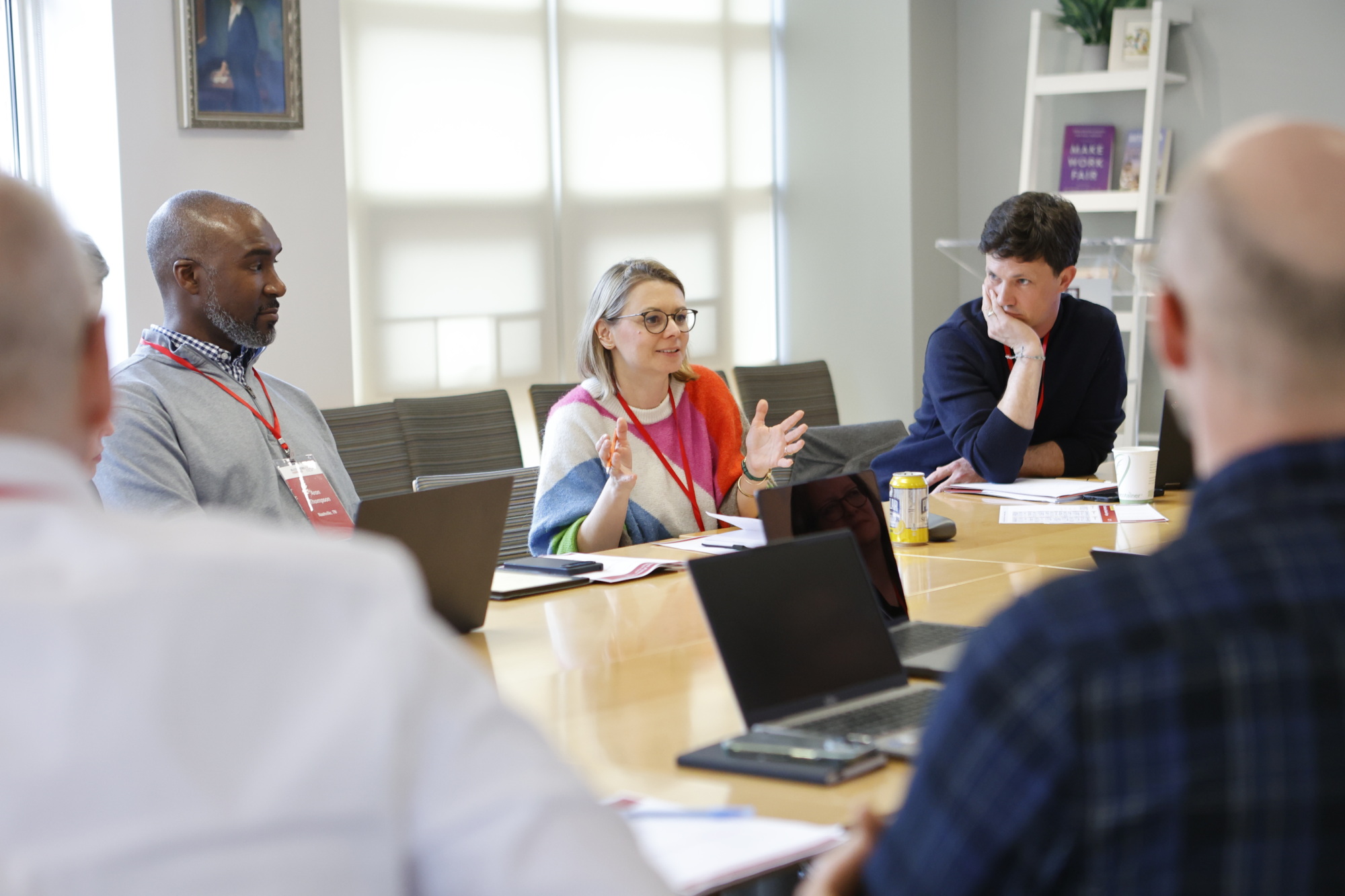Managing Floods, Revitalizing Neighborhoods, Saving Lives: Cities Mobilize Across Sectors to Tackle Tough Challenges

In the classroom, teams from 11 global cities deepen collaboration capabilities with Harvard faculty
Cambridge, Massachusetts (March 28, 2025) – Some of cities’ most complex challenges—like chronic flooding in Charleston, South Carolina; derelict, unsafe housing in Shreveport, Louisiana and Winnipeg, Canada; and youth at risk in Rosario, Argentina—require collaborative approaches across government, business, nonprofits, and communities.
In mid-March, the Bloomberg Harvard City Leadership Initiative brought 77 participants from multiple sectors to campus for intensive, in-person sessions as part of its nine-month Collaboration track. The 11 city teams invested in their collaboration, gained problem-solving tools, and designed plans to unite their diverse stakeholders and advance solutions to tough challenges.
Now in its eighth year, the Initiative—a partnership of Harvard Kennedy School, Harvard Business School, and Bloomberg Philanthropies based at the Bloomberg Center for Cities at Harvard University—equips mayors and their teams with research-backed programs and resources.
Entry Points to Collective Problem-Solving
What’s the key to tackling issues that have worsened, in many cases, for decades? Find a suitable entry point. An award-winning, peer-reviewed study published in The Journal of Applied Behavioral Science and supported by the Bloomberg Harvard City Leadership Initiative examined how public, for-profit, and civic organizations work to address city-wide social challenges. The research identified characteristics of entry points that led teams to success. Along with other scholarship, it informs the Collaboration track curriculum.
“In the Collaboration classroom, we study examples like the Chilean mining rescue of 2010 and the City of Cleveland’s recent work to advance inclusive prosperity in redeveloping its lakefront. Leaders explore ways to team up to innovate effectively,” said Kimberlyn Leary, Senior Fellow at the Bloomberg Center for Cities at Harvard University; Associate Professor of Psychology, Harvard Medical School; Associate Professor in the Department of Health Policy and Management, Harvard T.H. Chan School of Public Health; and Faculty Chair of the Collaboration track. “In addition to finding the right beginnings for making progress on wicked problems, leaders may need to overcome resistance to change, break down barriers holding teams back from innovating, open themselves to more inclusive input, and accelerate timelines to demonstrate to their communities that change is possible.”
Urgent Needs, Rapid Impact
Rain and tidal surges have become an existential issue for Charleston, South Carolina. Through participation in the Bloomberg Harvard program, the city’s collaboration team is developing a plan to address the impact of flooding, beginning over the next six months in the Ferguson Settlement Community – an underinvested part of town that presents immediate opportunities to improve drainage infrastructure and resident engagement.
Seattle is taking on revitalization of its Little Saigon area, working to reduce crime, homelessness, and drug addiction and improve conditions for residents, business, and visitors alike. Colorado Springs is restructuring how philanthropy and public funds align to better serve city needs, while Hartford is engaging the city’s largest employers in planning a job training program to bring greater opportunity to Hartford youth. Across all these efforts, the Initiative’s collaboration resources are aiding multi-sectoral leaders in teaming up and designing rapid steps toward impact.
Peer Support from Around the World
Separated by 1,300 miles and half a continent, Winnipeg, Canada and Shreveport, Louisiana came to the program with a similar priority: address vacant and blighted properties that depress property values, trigger public safety challenges, and mire entire neighborhoods in cycles of decline. “Our time in Cambridge has been amazing for a number of reasons,” said Marcus Edwards, Shreveport’s City Attorney. “Our team’s intensive focus got us toward an action plan. The frameworks, case studies, and skills-based learnings give us confidence in the work ahead. We’ll go home and convince people that great things can be done when we work together.”
“The initiative is helping us grow our capacity for big thinking and the tools for breaking through the status quo,” said Ashley Pledger, Winnipeg’s Deputy City Solicitor. “It’s also given us the rare gift of 10 peer cities around the world who understand what we’re trying to do and are invested in our success.”
Collaborations Yielding Successes
Boston, Massachusetts: Bringing Together Leaders from Across the City to Build an Equitable Workforce
Monterrey, Mexico: Taking Steps Toward Transforming Healthcare in Monterrey
South Yorkshire, UK: Collaborating Across the Community to Tackle Health Inequities
Discrete Steps Toward Turnarounds
This year’s 11 teams are sustained by thinking big—even as they recognize the work is just beginning. While launching their first steps, they aim to turn early action into major turnarounds.
The team from Rosario, Argentina, underscored the human toll of inaction: young people ages 12 to 25 suffer a homicide rate three times the city average. The Rosario team’s plan for investing in the troubled La Tablada neighborhood will target the roots of violence—keeping kids in school, clearing streets of crime and drugs, supporting families in need, and developing workforce pathways that can open up brighter futures for the city’s youth.
“Problems like these don’t fit neatly into departments or jurisdictions. We have to work across departments, across boundaries, and across perspectives,” said Rogelio Biazzi, Chief of Cabinet in Rosario. “Our team’s goal is to make the dream of the boys and girls of Tablada come true: a future where the improvements we make in education, job training, family support, and infrastructure will allow thousands of young people in our city to live safer and better lives.”


